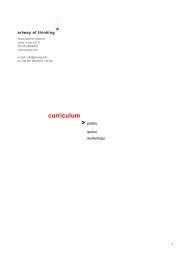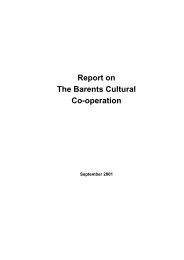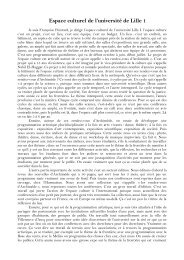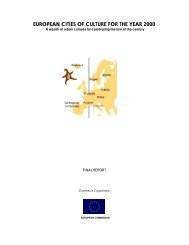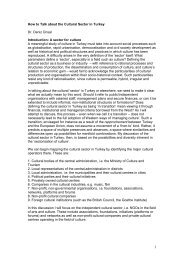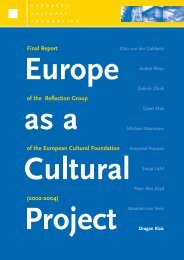A guide to the export and import of cultural goods between Russia ...
A guide to the export and import of cultural goods between Russia ...
A guide to the export and import of cultural goods between Russia ...
Create successful ePaper yourself
Turn your PDF publications into a flip-book with our unique Google optimized e-Paper software.
Sweden<br />
Chapter 3: European Union Member States<br />
For foreign <strong>cultural</strong> <strong>goods</strong>, a permit is only required if <strong>the</strong> <strong>goods</strong> have been in Sweden for<br />
more than 100 years.<br />
The Government has made regulations about categories, age <strong>and</strong> value thresholds <strong>and</strong><br />
o<strong>the</strong>r determining fac<strong>to</strong>rs (see <strong>the</strong> Heritage Conservation Ordinance, sections 24 & 25) concerning<br />
which <strong>cultural</strong> <strong>goods</strong> may not be taken out <strong>of</strong> Sweden without special permission.<br />
In addition <strong>to</strong> <strong>the</strong> Swedish national legislation, <strong>the</strong> EU legislation (as described in Chapter 2)<br />
applies <strong>to</strong> <strong>cultural</strong> <strong>goods</strong> which are <strong>export</strong>ed from Sweden <strong>to</strong> <strong>Russia</strong>, or <strong>to</strong> any o<strong>the</strong>r country<br />
outside <strong>the</strong> European Union. Cultural <strong>goods</strong> which come under this legislation (relevant<br />
categories apply, plus age <strong>and</strong> value thresholds) must have an EU <strong>export</strong> licence.<br />
The regulations for <strong>export</strong> licences apply <strong>to</strong> anyone who is <strong>export</strong>ing <strong>cultural</strong> <strong>goods</strong> from<br />
Sweden <strong>to</strong> ano<strong>the</strong>r country. They apply, whatever your nationality, citizenship, place <strong>of</strong><br />
residence or age. They apply whe<strong>the</strong>r you are an individual, a company (commercial or<br />
non-pr<strong>of</strong>it), a public institution or o<strong>the</strong>r organisation.<br />
They are explained in English <strong>and</strong> Swedish at: http://www.raa.se/cms/extern/en/<strong>cultural</strong>_<br />
heritage/legislation_<strong>and</strong>_responsibility/<strong>export</strong>ation_<strong>of</strong>_<strong>cultural</strong>_objects.html<br />
Are <strong>the</strong>re different types <strong>of</strong> licence? What type <strong>of</strong> licence do I need?<br />
There are two different types <strong>of</strong> licence:<br />
• The ‘<strong>export</strong> permit’ (under Swedish national legislation)<br />
• The ‘cus<strong>to</strong>m permit’, also known as EU <strong>export</strong> licence (under EU legislation for <strong>export</strong><br />
<strong>to</strong> countries outside <strong>the</strong> EU)<br />
If you are <strong>export</strong>ing <strong>cultural</strong> <strong>goods</strong> from Sweden <strong>to</strong> <strong>Russia</strong> you will need both licences, in<br />
order <strong>to</strong> comply with national <strong>and</strong> international regulations. The national ‘<strong>export</strong> permit’<br />
ensures that <strong>the</strong> <strong>goods</strong> are cleared for <strong>export</strong> from Sweden <strong>and</strong> is required when <strong>the</strong>y are<br />
part <strong>of</strong> <strong>the</strong> national <strong>cultural</strong> heritage or <strong>of</strong> o<strong>the</strong>r special significance. The EU <strong>export</strong> licence is<br />
required for <strong>cultural</strong> <strong>goods</strong> <strong>of</strong> a certain age or age <strong>and</strong> value when <strong>the</strong>y are <strong>to</strong> be moved from<br />
a member state <strong>to</strong> a country outside <strong>the</strong> EU. This is explained in more detail in Chapter 2.<br />
What are my first steps? How do I plan this process <strong>and</strong> how long might it take?<br />
Whatever <strong>the</strong> type <strong>of</strong> <strong>cultural</strong> object, you only have <strong>to</strong> deal with one authority – <strong>the</strong> National<br />
Heritage Board. You can get application forms from <strong>the</strong> National Heritage Board,<br />
which is also where you send <strong>the</strong> applications. Different application forms apply for <strong>the</strong><br />
national <strong>and</strong> EU licences but you follow <strong>the</strong> same application procedure.<br />
First <strong>of</strong> all, you must complete <strong>the</strong> application documents. If you want <strong>to</strong> <strong>export</strong> <strong>the</strong> object<br />
outside <strong>the</strong> European Union, you should note that you need two different forms. Attach<br />
two pho<strong>to</strong>graphs <strong>of</strong> <strong>the</strong> object <strong>to</strong> <strong>the</strong> application.<br />
The application procedure is described in more detail with downloadable forms at:<br />
216



